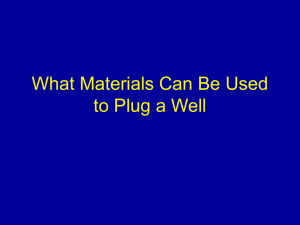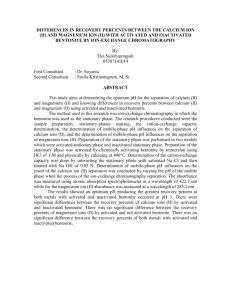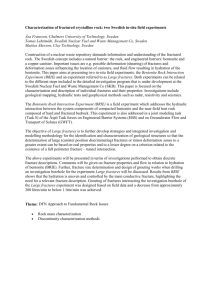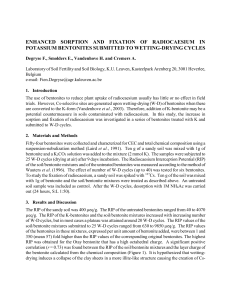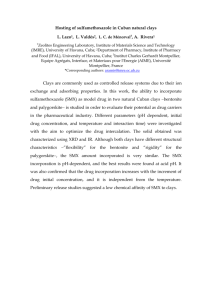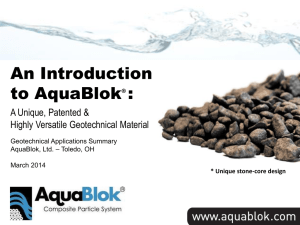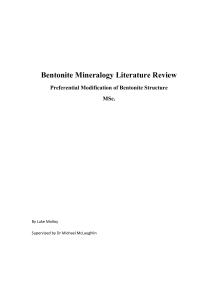bentonite resources of rajasthan
advertisement
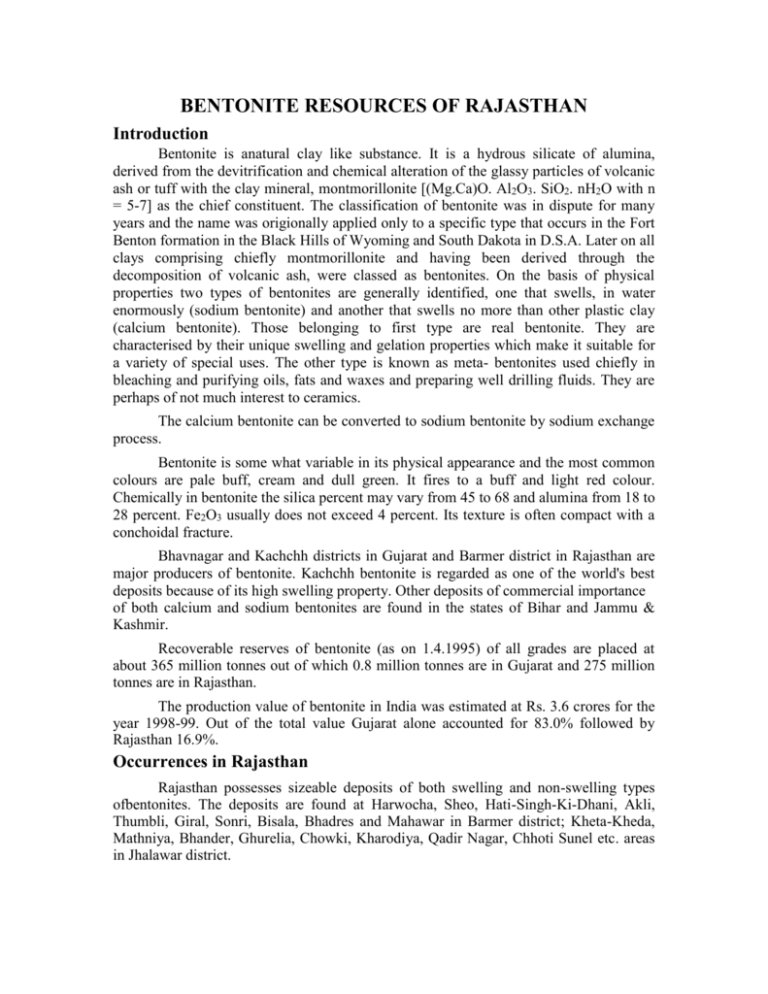
BENTONITE RESOURCES OF RAJASTHAN Introduction Bentonite is anatural clay like substance. It is a hydrous silicate of alumina, derived from the devitrification and chemical alteration of the glassy particles of volcanic ash or tuff with the clay mineral, montmorillonite [(Mg.Ca)O. Al2O3. SiO2. nH2O with n = 5-7] as the chief constituent. The classification of bentonite was in dispute for many years and the name was origionally applied only to a specific type that occurs in the Fort Benton formation in the Black Hills of Wyoming and South Dakota in D.S.A. Later on all clays comprising chiefly montmorillonite and having been derived through the decomposition of volcanic ash, were classed as bentonites. On the basis of physical properties two types of bentonites are generally identified, one that swells, in water enormously (sodium bentonite) and another that swells no more than other plastic clay (calcium bentonite). Those belonging to first type are real bentonite. They are characterised by their unique swelling and gelation properties which make it suitable for a variety of special uses. The other type is known as meta- bentonites used chiefly in bleaching and purifying oils, fats and waxes and preparing well drilling fluids. They are perhaps of not much interest to ceramics. The calcium bentonite can be converted to sodium bentonite by sodium exchange process. Bentonite is some what variable in its physical appearance and the most common colours are pale buff, cream and dull green. It fires to a buff and light red colour. Chemically in bentonite the silica percent may vary from 45 to 68 and alumina from 18 to 28 percent. Fe2O3 usually does not exceed 4 percent. Its texture is often compact with a conchoidal fracture. Bhavnagar and Kachchh districts in Gujarat and Barmer district in Rajasthan are major producers of bentonite. Kachchh bentonite is regarded as one of the world's best deposits because of its high swelling property. Other deposits of commercial importance of both calcium and sodium bentonites are found in the states of Bihar and Jammu & Kashmir. Recoverable reserves of bentonite (as on 1.4.1995) of all grades are placed at about 365 million tonnes out of which 0.8 million tonnes are in Gujarat and 275 million tonnes are in Rajasthan. The production value of bentonite in India was estimated at Rs. 3.6 crores for the year 1998-99. Out of the total value Gujarat alone accounted for 83.0% followed by Rajasthan 16.9%. Occurrences in Rajasthan Rajasthan possesses sizeable deposits of both swelling and non-swelling types ofbentonites. The deposits are found at Harwocha, Sheo, Hati-Singh-Ki-Dhani, Akli, Thumbli, Giral, Sonri, Bisala, Bhadres and Mahawar in Barmer district; Kheta-Kheda, Mathniya, Bhander, Ghurelia, Chowki, Kharodiya, Qadir Nagar, Chhoti Sunel etc. areas in Jhalawar district. Barmer district The bentonite deposits in the district are located in a NNW-SSE trending belt, extending for a distance of 86 km. (from Khoryal in the north to Mahawar in the south) and having about 8 km. width. Most of the deposits in this belt fall on either side of BarmerJ aisalmer metalled road and confined to the Akli and Lathi formations (Map-1). The details of the important occurrences are given below: Akli- Thumbli-Giral area: The deposits are situated 33 km. north of Barmer. In Akli area about 1 m. thick bed of bentonite of light green colour occurs under 1 m. thick overburden of sand. The material can be extracted in fairly large lumps. This bentonite appears to be of good quality, while the bentonite of Giral & Thumbli area is of inferior grade. From Akli to Giral and Thumbli, the bentonite beds grade from a swelling to a non-swelling type or is low-swelling type as in the Giral- Thumbli area. Hathi-Singh-Ki-Dhani : The deposits are situated 59 kms. north of Barmer alongwith Sheo-Harsani road and rises 10 to 12 m. above the surrounding land. An outcrop of bentonite covering an area of 33,000 to 1,00,000 square feet is exposed near HathiSingh-Ki-Dhani village. This bentonite horizon is about 6 m. thick and dips at an angle of 10° to 1'5°. The bentonite is grey or greenish grey in colour in the northern portion of the deposit and the southern most portion has stained yellow colour and so also is the material from the upper and the lower portions of the bed/horizon. The material, except being very slightly contaminated with sand, is free from any objectionable impurities such as gypsum, carbonaceous matter etc. The lowermost layer is said to contain some saline matter. This material occurs on plateau region and has thin overburden. The bentonite in most of the areas has only 30 cm. thick soil or loose sand cover. Barmer area: A 1.5 m. thick bed of bentonite is reported to occur under 1 m. thick overburden of sand and silt near the railway distant signal of Barmer railway station towards Hyderabad Sindh (Pakistan). The outcrop has been traced to a distance of 20 m. This material is iron-stained and is associated with lenticular bands of selenite. It is of inferior quality. Another exposure is noticed in a well near previous location at a depth of 6 m. and at a distance of 100 m. to the west. It is reported that 3 more bentonite deposits occur in an area within a radius of 2 kms from Barmer. These deposits are overlain by a thick overburden of sand. The quality of the material is considered to be good. Bhadras area: The bentonite deposits occupy a very large area east and south east of Bhadras village near milestone 17 (27.3 km. from Barmer) on the BarmerHarsani road. The bentonite is associated with Barmer sandstone of Kapurdi formation. In southeastern part it is associated with streaks of gypsum and reddish clay. Bisala area : The deposits are situated 1.5 km. north east of Bisala village which is 34 km. from Barmer on Barmer-Jaisalmer road. It is greyish to purplish in colour having about 2 m. thickness lying under 1.5 m. thick overburden of pebbles and boulders. The material is said to be contaminated with limonite in the lower portion of the deposit but this can be separated by simple hand picking. Sheo deposits: Deposits are situated 2 to 3 km. WSW and SW of Sheo. On the western limit of these deposits lie isolated outcrops of sandstone and on the east, north and south deep soil and sand cover. The Sheo deposits extend in N-S direction for more than 2 km. with an average width of 0.5 km. The thickness of the exposed bentonite ranges from 1.65 m. to as much as 5.45 m. Sheo-Kumaron-Ki-Dhani-Gunga deposits: All these deposits are situated around Sheo, Kumaron-KiDhani and Gunga villages and form part of a larger deposit that is now isolated by patches of sands and soil cover. The eastern extention of the above bentonite deposit is situated just east of Sheo. The aerial extent of this deposit is approximately 0.68 sq.km. There are three distinct horizons of bentonite observed in this area. The top most bed is a lensoidal body of about 15 cm. thickness and has been observed only in the southern portion of the deposit. The second horizon varies from 2.00 m. to 3.65 m. in thickness, the average being 2.5 m. It contains a few thin partings of weathered ferruginous shale, ferruginous nodules and fillings of limonitic material along cracks and joints. In the extreme southern portion it is almost devoid of gypsum. Presence of carbonaceous material is frequently observed in the central and northern parts of the block. The third horizon was exposed in a deep pit. Its thickness is about 4 m. of which only the top portion of 1.80 m. thickness is light grey bentonite of good quality. Kumaron-Ki-Dhani deposits: It lies just east of the village in relatively flat depression and extends towards NE and probably joins up with the Gunga bentonite deposits. Bentonite body seems to be extending in the east but here the soil cover has progressively become thicker. The exposed length of bentonite body is 600 m. and width 500 m. Bentonite beds range in exposed thickness from 1 m. to 2.70 m., the average being above 2 m. Gunga deposit: It lies on either sides of BarmerJaisalmer road close to the village Gunga, therefore divided into two parts i.e. west of the road and east of the road. Gunga west bentonite deposit extends for about 0.6 km. in NW-SE direction with an average width of 400 m., where as Gunga east deposit extends in a more or less north-south direction for about 0.7 km. with an average width of 350 m. The thickness of the bentonite beds ranges from 0.85 to 3.6 metres, the average being 2.0 to 2.5 m. The bentonite beds continue towards south with intervening patches of blown sand and join up with the Sheo bentonite but are covered extensively in the north, east and west by dune sands. Bentonites are mostly greyish white with some reddish yellow patches. Bending in bentonite is fine often rhythmic and generally horizontal. Thin veins and stringers of gypsum commonly occur in bentonite along fractures and joints. Deoka-Khorayal deposits: Two separate deposits of bentonite lie adjacent to the western side of BarmerJaisalmer road, which lie respectively, 2.7 and 1.5 km. south-west and north of Deoka village. The two occurrences are separated by sand dunes and a few isolated outcrops of sandstone. The Deoka bentonite deposit no. 1 extends in NNE-SSW direction for about 2 km. with an average width of 300 m. The maximum thickness of the bentonite body is 2.85 m. with an average thickness of 1.8 metres. The deposit no. 2 extends for about 1.6 km. in NNE-SSW with an average width 200 m. The thickness of the bentonite beds ranges from less than 0.50 m. upto 2.45 m. the average being 2 m. Both the deposits are covered on east, west and south sides by thick soil cover and blown sands. The bentonite deposits continue northward and join with the Khorayal bentonite body. Khorayal deposit: Two separated bentonite deposits namely 1 and 2 are located respectively at 1.5 km. north and west of the village Khorayal along BarmerJaisalmer road. The first Khorayal bentonite deposit extends in NE-SW to north-south direction for about 1.35 km. length with an average width of 100 m. The thickness ranges from 1.35 m. to 2.35 m. The second deposit extends in NNW-SSE for about 0.75 km. with an average width of 300 m. The thickness of the bentonite varies from 0.75 m. to 2.45 m. Average thickness for both the bentonite deposits is about 2 m. Both at Deoka and Khorayal, bentonite occurs in flat ground under a thin (0.3 to 1 m. thick) cover of soil and loose sands. Bentonite is mostly greyish-white coloured with reddish yellow patches and often cut across by thin veins and stringers of gypsum. Mandai deposit: Mandai bentonite deposit lies within and around the village Mandai. Here bentonite is exposed along nalas close to the hill slopes and in shallow pits. Occurrences of bentonite are also noted towards north-west from Mandai for about 2 to 3 km. Isolated exposures of bentonite are seen in pits near Sajit, 7 km. north-west of Mandai. Mandai bentonite body extends in NE-SW for about 1.3 km. with an average width of 500 m. The thickness of the bentonite body ranges from 0.50 metre to 5.15 metres. The average thickness of Mandai bentonite-block 'A' is about 4 metres and in block 'B' is about 2 metres. Mandai bentonite body is bounded on south, east and north by outcrops of Lathi sandstone and on the north-west by loose sand. In south of the village Mandai, thin layers of bentonite found interbedded with phosphate rich, fossiliferous (lamellibranchs), calcareous sandstone and shales. Bentonite is greyish-white in colour, lumpy and very 1 loose in nature. Bentonite bandings are generally gently dipping towards east at very low angle ie. 15° to 20°. Harwaccha : About 3 m. thick bed of bentonite striking N-S over 250 m.length with 80 m. width is found exposed in nala bed at about 700 m. west of Harwaccha. The bentonite is greyish in colour and breaks down to small fragments on exposure to atmosphere. Three distinct beds of bentonite separated by iron stone are observed in this section. At the centre of the beds the overburden is almost negligible but it increases in both north and south directions. Giral : Number of old pits, worked to get bentonitic clay are found at about 300 m. west of Giral,. The thickness of bentonite bed is about 5 m. and can be traced over 150 m. long and 70 m. wide area. The bentonite is usually stained yellowish, and is frequently contaminated with ferruginous clayey matter and some occassional flakes of gypsum. The average overburden thickness is 1.5 m. Thumbli deposit: This is the southern extention of the high swelling Akli bentonite deposit aI:ld lies 3 km. south-west of Thumbli. It is extending in south and east wards for 0.16 sq. km. area. The overburden in general is 0.80 m. to 1.25 m. thick and composed of compact sandy soil with carbonate and salt, followed by a hard compact granular horizon. The bentonite is brownish to purplish colour towards the top portion while it is grey with purple bands in the lower portion. The bentonite is 2.45 to 3.90 m. thick, the average being 3.20 m. Harwa deposit: The flat ground lying 1 km. NNE of village Harwa (on the western side of NH-15), is occupied by bentonite. The deposit is extending for 0.70 sq. km area. The thickness of the bentonite hirozon varies from 1.70 m. to 3.50 m. beyond which the quality deteriorates. At places the bentonite contains a little gypsum and ferruginous nodules. The overburden thickness varies from 0.45 to 1.70 m. It is comprised of loose as well as compact sand having fragments of ferruginous shale. The bentonite is generally grey coloured but purple, yellow and greyish brown colours are also present. Bisu Kalan South deposit: The deposit is located just south of the Bisu Kalan village. It consists of two bands of bentonite separated from each other by 5 to 10 cm. thick ferruginous sand stone bands. The bentonite is light grey to grey coloured and partly it is pale yellow and laminated. The thickness of the upper band varies from 0.50 to 0.70 m. with an average of 0.50 m. The lower band shows no indication of bottoming. The lower band is of good and uniform quality where as the upper one is of inferior quality because of its intermixing with loose sand and overbuden clay. The oveburden of loose sandy soil, hard bentonite and occassional kankar is 0.52 to 1.60 m. thick. MAP-1 Bisu Kalan North deposit: The deposit lies just north of Bisu Kalan village. Here also two bands of grey to yellowish coloured, laminated bentonite separated by 5 to 10 cm. thick sand stone, occurs below an overburden of 10 to 30 cm. The upper band which is 0.45 to 0.75 m. thick (average 0.5 rn.) is inferior in quality where as the lower band is more then 2 m. thick and is of good quality. Mahawar area: The deppsit is situated 1.5 km. SW of village Mahawar which lies 4.8 km. from Barmer on Barmer- Dhorimana road. The bentonite beds in this area are distributed in an area of 2.6 sq. km. having a thickness of 1 to 3 m. The overburden of sand, kankar and conglomerate varies from 1 to 3 m. Other Occurrences: Minor bentonite occurrences are also observed at a few other places in the area i.e. at the base of conical hill just north of Daijar Ka Dungar, Baisala, Purad, Dharvi Khurd, Ratta Kumaron Ki Dhani, Sonari, Maobar Kalan, HapaKi-Dhani, Parasar Nadi, Ambabori etc. area. Reserves and other details Reserves and important physical properties of the various bentonite clay deposits of Barmer district is shown in the following table. S.No. 1. 2. 3. 4. 5. 6. 7. 8. 9. 10. 11. 12. 13. 14. 15. 16. 17. 18. 19. 20. 21. Name of the area Swelling index Gel volume (in ml) Akli Thumbli Giral Hathi Singh Ki Dhani Bhadras Bisala Sheo-1 Sheo-2 Sheo-3 Sheo-4 Kumaron Ki Dhani Gunga-1 Gunga-2 Deoka-1 Deoka-2 Khorayal-1 Khorayal-2 Mandai Harwaccha Harwa Bisu Kalan South BK-1 6-15 2-13.5 2.7 upto20 7.5-22 6.3-7.7 2-3.2 4-13 1-13 3.4 2-3.1 2.1-4.0 1.5-2.5 3-15 5-13 4-6 3-10 5-8 - - 2.1-3.3 2.1-3.1 2-10 2-3.2 2.5-4.3 2.0-3.3 2.8-17.5 2.0-4.6 2.7-5.5 4-10 4-10 4-22 4-7 4-9 3-7 4-13 2-11 6-15 2.5-5.0 6-11.5 Reserve (in MT) 0.084 1.067 0.075 0.075 2.24 1.44 0.57 7.792 0.65 0.81 0.95 0.45 0.97 0.53 0.77 2.88 0.10 3.728 7.02 22. 23. 24. 25. 26. Bisu Kalan North BK-2 Mahawar Pusad Ratta Kumaronb Ki Dhani Barmer 2.5-4.5 5.5-8.5 2-4 3-3.5 8-11 6.5 3 5-6 - 5 8.15 1.04 1.08 - Jhalwar district The state department of Mines & Geology has located and explored the grey and red coloured bentonite deposits in the district (Map-2). The grey bentonites are of good quality as compared to red bentonites. The beltwise description of the grey variety bentonite is as under: Mathaniya-Bhandar area: The village Mathaniya is located 15 kms south of Sunel and 12 kms SW of Raipur. The deposit is found spread over an area of almost 3.50 sq. km. around villages Mathaniya, Bhandar and Naklong. The bentonite occurs below 26 m. thick overburden of black soil and weathered traps. The bentonite bed has a thickness varying from 0.60 m. to 5.20 m. with average thickness of about 2 m. Karodiya, Nagar, Chhoti Sunel area: The grey and mixed (red and grey) bentonite deposits have been located near Karodiya, Qadir Nagar, Kundla, Pratap and Chhoti Sunel villages. The grey bentonite with intercalations of red variety is found in 2 km. east of Karodiya village in an area of about 0.5 sq. km. Thickness of bentonite bed varies from 0.65 to 2.55 m. and occurs under the 0.10 to 0.50 m. thick over burden. Similarly grey bentonite is also found to occur around Qadirnagar, Kundla, Pratap, Chhoti Sunel, Charalia and Kasarpura villages. This bentonite occurs in 3 sq.km. area at a depth of 0.10 to 2.00 m. and thickness varies from 0.5 to as much as 5 m. Kheta-Kheda: Village Kheta-Kheda is situated about 15 kms. from Bhawani Mandi on Jhalawar-Sunel road. The calcium based bentonite is found in about 2 sq. km. area. The bentonite occurs at a depth of 0.50 to 14.70 m. under 0.25 to 5.95 m. thick overburden of soil, traps and calcareous chert. The bentonite of this area is of nonswelling type and do not respond to acid activation. Since it occurs at greater depth and requires pre-treatment before its any use, the mining of this deposit will not be economic. Chand Kheri: About 0.57 MT tonnes of grey bentonite and 4.53 MT of grey mixed with red bentonite have been proved in 2.75 sq. km. area near vilage Chand Kheri . It was found that this is calcium based, non swelling type and requires activation before marketing. Following table shows the properties and reserves of various bentonite occurrences/ deposits of Jhalawar district. S.No. 1. 2. 3. 4. Location Swelling index Mathniya – Bhandar 7-22 area Karodiya Qadir 10-24 Nagar & Chhoti Sunel Non Swellin g Kheta-Kheda -doChand Kheri Gel volume (in ml) 9-10 Reserve (in MT) 1.27 10-12 1.78 7-11 - 13MT 5.10 MT Uses and specification Bentonite largely finds its use in foundary facings, as construction aid in civil engineering (in areas of unconsolidated rock or soil to prevent fluid loss, caving, etc.); for pelletisation of iron ore fines; for preparation of drilling mud mostly for oil-well drilling and as an aid / diluent in insecticides / pharmaceuticals. Other important uses of bentonite are in refractory / ceramics, chemical, fertilizers (as filler) and in welding electrode industries. It is also used as a decolouriser for oils and other liquids in place of adsorbent charcoal and as rubber filler. It may discolour white wares if more than 2 to 2 ½% bentonite is used. Bentonite absorbs water to form either sols or gels depending upon its concentration. In aqueous-sols and gels bentonite particles are negatively charged and flocculation occurs when electrolytes or positively charged ions are added. Because of this property, bentonite is sometimes used in clarifying turbid liquids. Consumption of bentonite in the organised sector during 1994-95 was 149,900 tonnes only as compared to 152,000 tonnes in the previous year. Out of total consumption, foundary industry accounted for 32% followed by Civil Construction (19%), pelletization (17%), oil-well drilling (15%) and refractories (3%). The rest of the consumption (14%) was accounted for ceramics, chemicals, insecticides, fertilizers etc. In foundary castings of iron and other ferro-alloys, 5 to 10% bentonite is added to the sand. The norm of consumption of bentonite for preparing drilling muds varies from field to field and also depends on drilling conditions and the quality of bentonite used. It is usually 15 to 24 tonnes for 1,000 m. drilling. There are three types of bentonite classfied as follows: Type-l Type-2 Type-3 Suitable for chemical industries including decolourising of petroleum and vegetable oils, and rubber industry with some additional requirement. Suitable for foundaries. Suitable for oil-well drilling. Requirements for bentonite Additional requirements for bentonite for rubber industry S.No. (i) (ii) (iii) (iv) Characteristics Loss on ignition (other than loss on drying), percent by weight, Max. Matter soluble in water, percent by weight, Max. Copper (as CuO), percent by weight, Max. Manganese (as Mng), Percent by weight, Max. Requirement 6.0 4.0 0.01 0.01 Various tests of bentonite (A) Gel formation index determination: (1) Mix 6 gm. of the dried material intimately with 0.3 gm. of light magnesium oxide, add the mixture in small quantities to 200 ml. of water contained in a 500 ml. stoppered measuring cylinder; agitate thoroughly for one hour; tans fer 100 ml. to a 100 ml. measuring cylinder and allow to stand for 24 hours. The material shall satisfy the requirements of the test if not more than 2 ml. of clean liquid separates at the surface. (2) Weigh accurately 1.4 gm. of the dried material, 2.6 gm. of alumina and 0.2 gm. of magnesium oxide, mix them thoroughly and shake with 100 ml. of water for one hour in a stoppered measuring cylinder. Allow the contents of the measuring cylinder to stand for 24 hours. Measure the volume of supematant liquid and subtract it from 100 ml. This will give roughly the gel index value of bentonite in percent. (3) ASTM method: The following method described in the American Colloid Co., Data sheet No. 251 can be adopted for estimating the gel volume. 100 cc. of distilled water is taken in measuring cylinder of 100 cc. capacity. Two gms. of the oven dried bentonite is added in small portions (say 0.2 gms.) at intervals, after allowing each portion to settle down prior to adding another. The volume (in cc) of the bentonite gel (gel volume) will be noted an hour after the last portion was added. (B) Swelling Power: (I) Add 2.0 gm. of the dried material in 20 approximately equal portions at intervals of two minutes to 100 ml. of solution of sodium lauryl sulphate (one percent w/v) contained in 100 ml. measuring cylinder. The material shall satisfy the requirements of the test, if it swells to an apparent volume of not less than 24 ml. in 24 hours. (2) The dried bentonite powder is placed in a 100 cc. measuring cylinder. The volume of the dried bentonite (approximately 30 cc.) is noted after gentle tapping to allow the powder to settle down. The bentonite should be thoroughly mixed with 500 cc. of distilled water in a graduated cylinder of 500 cc. capacity. The ratio of the volume of the dry bentonite powder will be the swelling index of bentonite. (C) Activation: The need of activation of bentonite is felt because certain low grade bentonite does not have the required characteristics like swelling, bleaching etc. Because of the typical cation exchange characteristics, bentonite could be treated with acid or alkalies to allow to exchange positively charged ions e.g. H+ or Na+ with Ca and Mg present in it. With this exchange, bentonite acquires swelling, bleaching and other characteristics. (1) Acid activation method: Take 100 gms. of sample (oven dried), treat it with 25% H2 SO4 (sulphuric acid) and boil for 3 hours with constant stirring. Filter the slurry and wash it with distilled water until it is free from SO4. Dry the cake in oven at 1050 C. This cake is acid activated bentonite. (2) Alkali activation method: Take 100 gms. sample (oven dried) Treat with 5% sodium carbonate solution and stir it for 2 hours. Dry the slurry in oven at 1050 C. This cake is alkali activated bentonite. Statistical information of mineral bentonite in Rajasthan Year Production (000" T) Revenue (000" Rs.) No. of leases 1996-1997 59.620 2111.730 19 1997-1998 54.798 1917.930 20 1998-1999 48.556 1923.520 18 1999-2000 66.485 2335.280 16 2000-2001 57.831 2075.060 16 District wise No. of leases and production of bentonite in Rajasthan (Year 2000-2001) District Barmer Jaisalmer Jhalawar Total No.of leases 13 0 3 16 Production (000" T) 57.000 0.000 0.831 57.831 Sale Value (lacs Rs.) 57.000 0.000 5.810 62.810 Revenue (000" Rs.) 2003.440 50.620 21.000 2075.060
